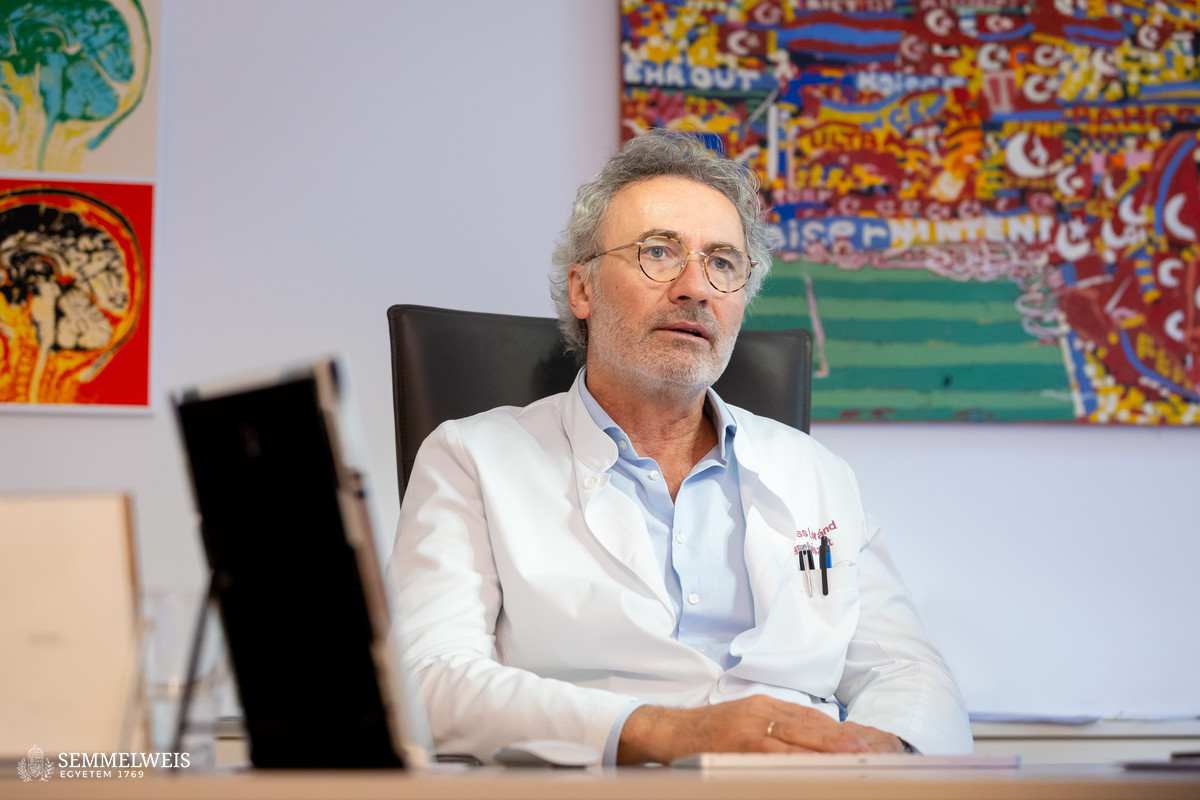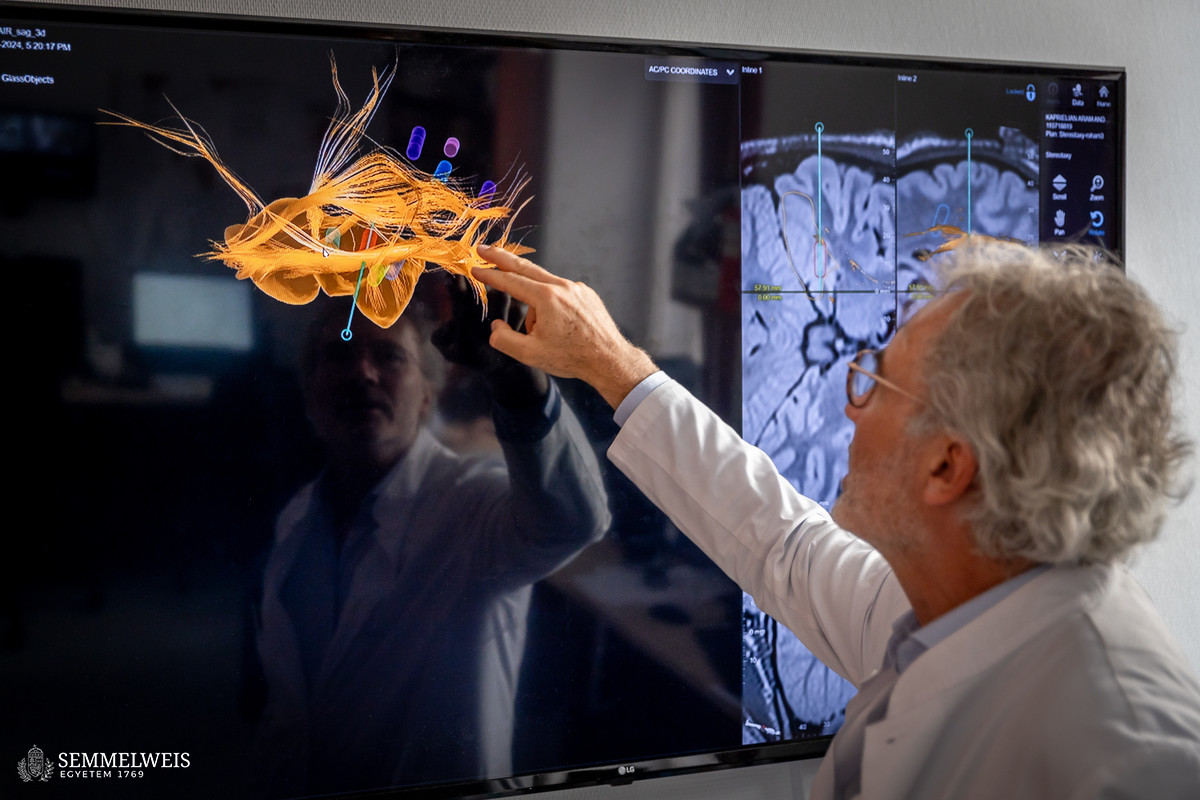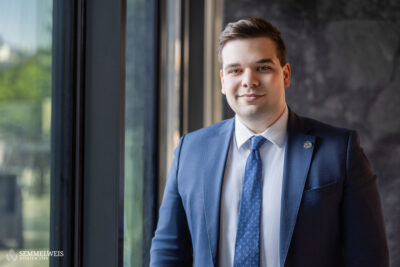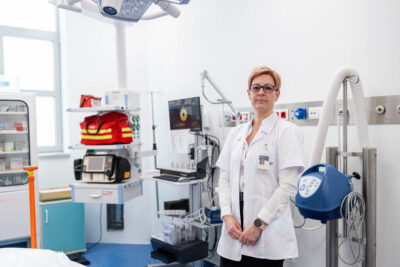“For a surgeon, the state of flow is elicited by operation. If I look back on the past 33 years, I have experienced it almost every day, despite the difficulties of our profession, as we often treat patients who cannot be assisted. But whether we merely relieve the patient’s pain or provide a cure, it is a confirmation for a doctor that it was a profession worth choosing,” said Dr. Loránd Erőss on why it is necessary for him to stay close to the operating room, even if only visually. “That is the reason why I have the antique lamps of our old operating rooms above me, so that I always know where I belong and can see why I am here,” he added.
My father was an architect, so visual art is close to my heart. The three-dimensional imaging used in our profession, or the beautiful world of intracranial (brain) cisterns at the base of the skull gives me a distinct artistic experience. Our work is inspired by this created perfection.
As a third- and fourth-year medical student, Dr. Loránd Erőss attended the Városmajor Heart and Vascular Center and was preparing for a career as a cardiac surgeon under the influence of Professor Dr. Zoltán Szabó. He did his clinical placements in England, where, however, he turned to neurosurgery.
It was the first time that I saw an open skull, and I was very struck by the way the ‘personality’ of a human was pulsating there. In fact, it was the personal, emotional influences I experienced during my clinical training at the university that pushed me in this direction.
At that time, a Bristol-based neurosurgeon was heading to the Himalayas as a mountaineer to study the physiological effects of high-altitude conditions as part of a major research grant, sponsored in part by the BBC. He had an intracranial epidural pressure gauge inserted into his skull by a friend. While we were seeing patients, blood started dripping from under the dressing because he came straight from the operating room and the wound was still fresh. The patient was shocked and exclaimed, “Doctor, your head is bleeding!” “No problem, I’ve just had surgery, it’s just a weak stitch, it should stop,” he replied to the terrified patient, laughing, and then a few days later he was off to climb Mount Everest. Such things stick with the medic,” he recalled his formative experiences.
He has been working as a lecturer at Semmelweis University since the 1990s, and later also worked at Pázmány Péter Catholic University and the University of Szeged, where he launched the functional neurosurgery program. “As experienced professionals, our presence in education is very important because that’s how we can motivate young people. Mere dry data is not as interesting as a walk of life,” he pointed out.
With the integration of the National Institute of Mental Health, Neurology and Neurosurgery (OMIII) and its neurology, neurointerventional, and neurosurgical care on March 1, 2024, neurosurgery, neurointerventional stroke care, comprehensive epilepsy care, and neuromodulation have been added to Semmelweis University’s scope of care for the adult population.
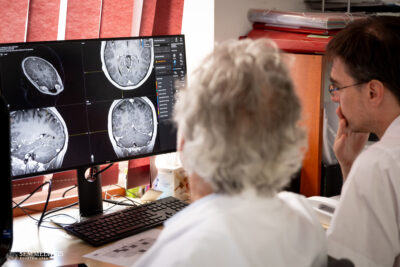 “I believe that the university environment is an additional motivation for our department, which already has a national duty of care, and this has contributed to the birth of a department that the university has long intended to establish,” he underlined. Dr. Loránd Erőss also added that the teaching tasks would be quantitatively expanded because neurosurgery, neurology, and neurointervention have been included so far, but now they would be given more emphasis in the curriculum. As for scientific activities, he thinks that if innovative projects could be launched and continued with the help of the university, for example by supporting tendering conditions, then everyone would benefit. In 2023, 165 publications were written at the department colloquially referred to as the Amerikai Road Institute.
“I believe that the university environment is an additional motivation for our department, which already has a national duty of care, and this has contributed to the birth of a department that the university has long intended to establish,” he underlined. Dr. Loránd Erőss also added that the teaching tasks would be quantitatively expanded because neurosurgery, neurology, and neurointervention have been included so far, but now they would be given more emphasis in the curriculum. As for scientific activities, he thinks that if innovative projects could be launched and continued with the help of the university, for example by supporting tendering conditions, then everyone would benefit. In 2023, 165 publications were written at the department colloquially referred to as the Amerikai Road Institute.
The Department of Neurosurgery and Neurointervention is the third-largest neurosurgery center in Europe. The 175-bed institution employs 112 doctors and 321 allied health professionals. It houses Hungary’s first and only pediatric neurosurgery ward, where 500 patients are admitted each year, 350 patients undergo surgery, and around 3,000 children are treated as outpatients.
The neuro-oncology ward performed 740 brain tumor surgeries in 2023; the minimally invasive endoscopic skull base surgery program is led by one of the world’s leading skull base surgeons; and spine surgery is also done frequently, with 800 to 1000 cases annually by applying the biportal endoscopic spine surgery technique, as the only service provider in Hungary. Established in 2010, the functional neurosurgery ward performs unique procedures such as epilepsy surgery, movement disorder surgery, and state-of-the-art invasive neuromodulation procedures, to name but a few. Neurointervention is one of the flagship treatments in Hungarian stroke care, with the ward performing the largest number of interventional thrombectomies in Europe. Similarly, robot-assisted neurosurgical procedures have been performed only here in Hungary since 2018; and we are also contributing to developing the software for the robot itself, the director pointed out.
Dr. Loránd Erőss also explained that under the leadership of the Amerikai Road Institute, e-Stroke, an AI-based central decision support system, which is remarkable worldwide, had been implemented for stroke care. With the aid of this system, decisions on the further treatment of stroke patients can be made much faster than before, and if necessary, further transport and life-saving surgical intervention can be started immediately. The National Stroke Registry (NSR) is also run by the Department of Neurosurgery and Neurointervention as the legal successor of OMIII. The registry has accumulated a 500-terabyte data warehouse over the past 3 years, which contains around 500,000 patient records, allowing the entire life course of stroke patients to be tracked. This also serves public health purposes, as it allows for planning the optimization of healthcare for a given cohort of patients, the director highlighted.
Dr. Loránd Erőss graduated from the Piarist Secondary School in Budapest in 1983 and from the Faculty of Medicine at the then-Semmelweis University of Medicine in 1990. He obtained board certification in neurology in 1995 as well as in neurological surgery in 2000. In 2007, he was among the first ones in Hungary to pass the Fellow of International Interventional Pain Practice (FIPP) Examination. He received his PhD degree in neuroscience in 2010. He got his habilitation at Semmelweis University in 2019 in epilepsy surgery. Also in 2019, he completed the Surgical Leadership Program offered by Harvard Medical School and Harvard Business School.
 Many innovations are accredited to Dr. Loránd Erőss, including the introduction of new surgical techniques for the treatment of epilepsy. In his view, innovation is always the product of collective thinking. “I’ve been able to take charge of a lot of procedures and innovative initiatives because I work in multidisciplinary teams,” he said, adding that one had to keep constantly up to datein one’s profession; surgical technology can always be refined, fixed, and improved. According to the director, robotic surgery has already “brought us into the future.” As medical staff is shrinking and aging worldwide, we will increasingly rely on telemedicine tools, which will also affect robotization.
Many innovations are accredited to Dr. Loránd Erőss, including the introduction of new surgical techniques for the treatment of epilepsy. In his view, innovation is always the product of collective thinking. “I’ve been able to take charge of a lot of procedures and innovative initiatives because I work in multidisciplinary teams,” he said, adding that one had to keep constantly up to datein one’s profession; surgical technology can always be refined, fixed, and improved. According to the director, robotic surgery has already “brought us into the future.” As medical staff is shrinking and aging worldwide, we will increasingly rely on telemedicine tools, which will also affect robotization.
Eszter Keresztes
Translation: Judit Szabados-Dőtsch
Photos by Boglárka Zellei – Semmelweis University

